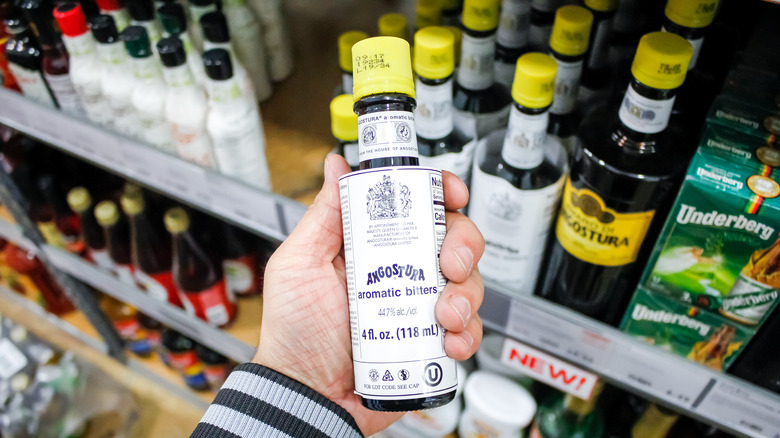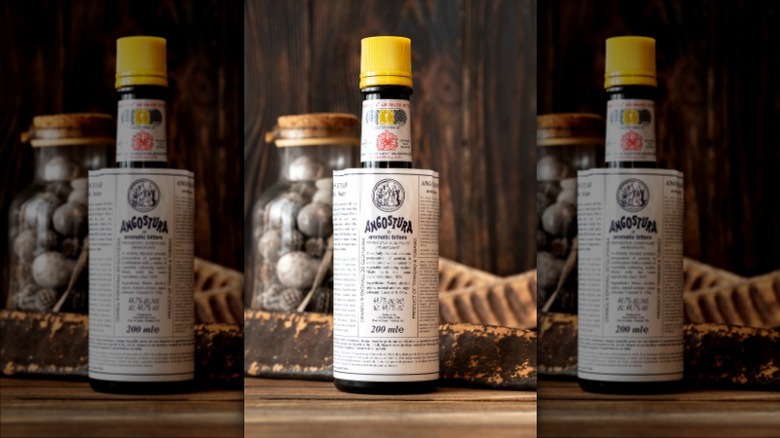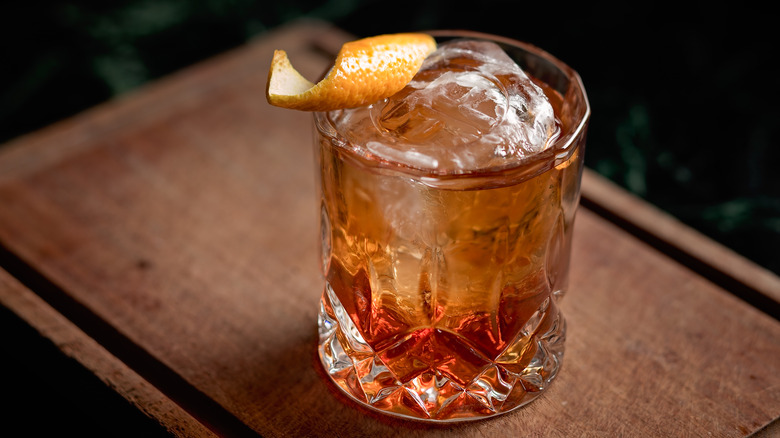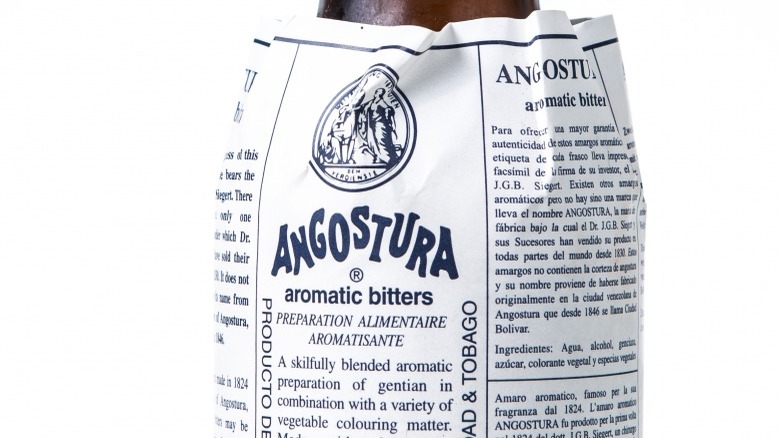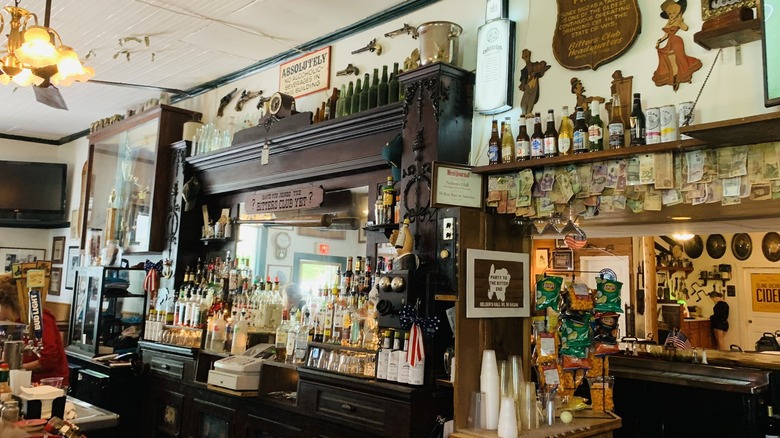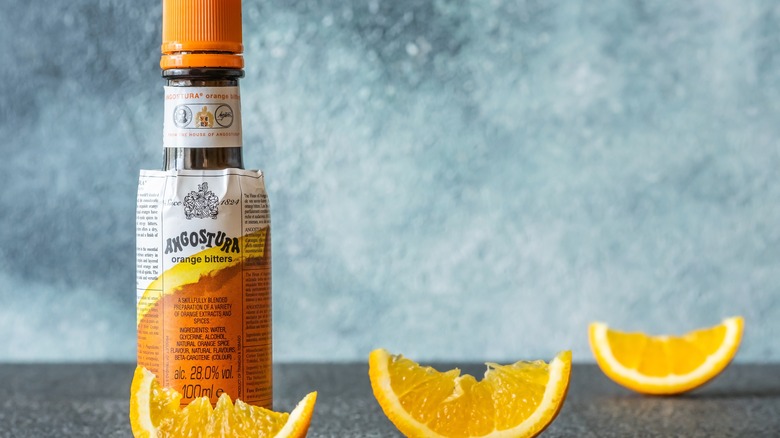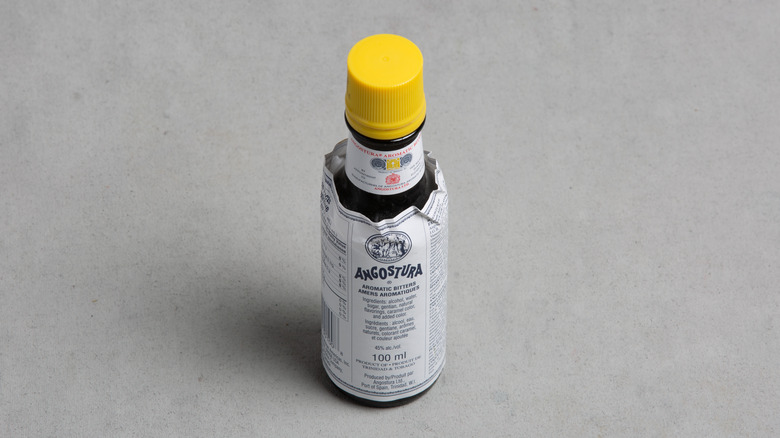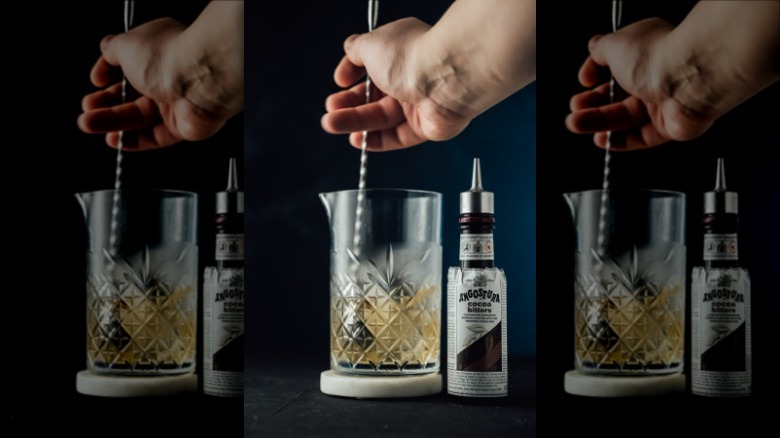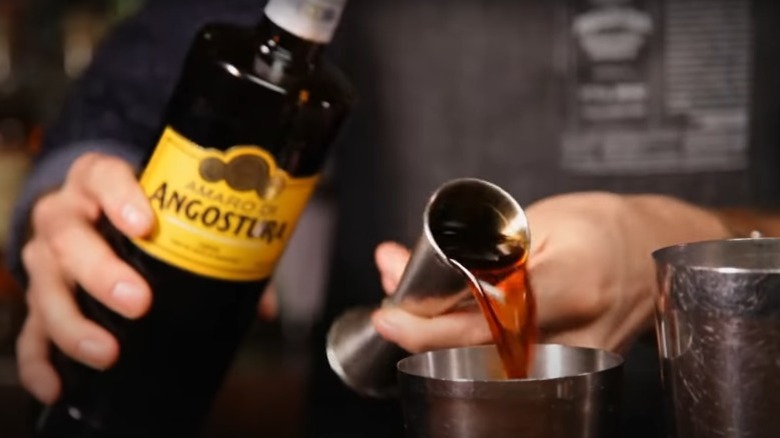The Ultimate Guide To Angostura Bitters
Bitters are a group of usually alcoholic liquids that are infused with a variety of botanical substances including bark, seeds, and roots. Of all the brands of bitters in the world, one stands out thanks to its oversized label and bright yellow cap — Angostura and its bitters are an instantly recognizable feature of all cocktail bars. This iconic design — and taste — has meant that Angostura is the leading global brand of bitters by far.
The use of bitters has a long history which dates back to ancient Egypt. However, it was much later, during the 18th and 19th centuries, when bitters became a common medicinal tonic used by doctors and prescribed by pharmacists for a variety of illnesses. Steadily, the potent liquid became associated with cocktails, especially as the U.S. plunged into Prohibition. Since this time, the two have become almost inseparable.
A nearly 200-year-old product, Angostura's bitters have maintained a shroud of mystery thanks to the brand's fiercely guarded secret recipe. Yet, the impact the bitters have had on the drinking and cooking worlds is apparent for all to see. Here, we examine that impact along with a few other choice pieces of information about the most esteemed bitters in the world.
Angostura bitters are made in Trinidad and Tobago
The name "Angostura bitters" pays homage to the spirit's birthplace, the city of Angostura – now known as Ciudad Bolívar — in Venezuela. Invented by a German doctor, Johann Gottlieb Benjamin Siegert, the secret recipe was handed down to his children, Carlos, Alfredo, and Luis. This trio left Venezuela for Trinidad and Tobago in 1875, setting up a new factory in the islands' capital, Port of Spain. Angostura bitters have been made in this location ever since.
After nearly 150 years of production, it is unsurprising that Angostura bitters form a huge part of Trinidadian culture. John Georges, a master distiller at Angostura, highlighted this to Vice: "Right alongside the steel band and calypso, Angostura bitters is one of those things that we have given to the world. Okay, technically speaking, it came from Venezuela, but it's been here forever and it's ours now. The Venezuelans can't claim it. The Germans can't claim it. We claim it in Trinidad. It is ours."
Originally, the bitters were a medicinal tonic
As surgeon general under Simón Bolívar, Dr. Johann Siegert saw a lot of soldiers, sailors, and civilians struck down with stomach ailments. Seeking to solve this issue, the doctor began the process of developing his own medicinal tonic. In 1824, his recipe was complete. It has not been altered since.
Originally, the medicine, known as Amargo Aromatico, was only given to Siegert's patients and close connections, but the tonic proved so effective at solving issues such as seasickness that it was eventually being exported to England, the United States, and elsewhere in the Caribbean. It was a part of rations on many ships, and British sailors began to mix it with their gin, creating a rudimentary version of the pink gin cocktail.
Angostura bitters are still used as medicine today, especially in Trinidad and Tobago. The bitters are a great option for those with a hangover. Pedro Martinez, co-owner of a cocktail bar in Paris, tells GQ Magazine, "Most bitters were created to cure stomach aches and other nasty digestive ailments from the pre-pasteurization and water filtering era. I'm not sure they will help you with the steam hammer inside your head, but they will do the thing with that stomach discomfort."
They play an integral part in some of the world's most famous cocktails
The best setting for Angostura bitters is the cocktail bar. Here, the bitters are used to add complexity to drinks while also teasing out the flavors of other ingredients. This notion is highlighted by award-winning Trinidadian bartender Raymond Edwards: "It [Angostura bitters] has a unique blend of secret herbs and spices which brings out the inherent flavours in so many concoctions, totally. As a professional bartender, when you create and mix a cocktail, there is supposed to be a balance, with neither the alcohol nor the base overpowering the other. And then, with the bitters, you pick up the hints of everything that is in there" (via Caribbean Beat Magazine).
Thanks to their medicinal uses, Angostura bitters could continue to be sold during Prohibition. Most of the liquor available in the United States during Prohibition was incredibly harsh and borderline unpalatable. As such, people took to mixing other ingredients into the liquor, birthing the modern cocktail. Thanks to its availability, bitters such as Angostura became a common ingredient in cocktails and have only become more commonplace in recent decades.
Today, a plethora of the world's most famous cocktails, including the old fashioned, Manhattan, and pink gin, contain Angostura bitters. There are also numerous other drinks that spotlight the bitters, including the increasingly popular Trinidad sour, which contains a whopping one and a half shots of Angostura bitters.
The recipe is known to only five people in the world
The recipe for Angostura bitters is a closely guarded secret that has been kept for nearly 200 years. Reportedly, the recipe is only known to five people at any given time.
Limiting access to the recipe is not the only way the House of Angostura protects its recipe. All raw ingredients for the bitters are ordered separately to England, including an assortment of spices, herbs, and other ingredients that are not used in the production process. These serve to confuse any people who might try to copy the recipe based off the company's orders. In England, all ingredients are repackaged into unlabeled containers before being shipped to Trinidad and Tobago. When they arrive, the packages are not even checked by customs in order to ensure their contents remain secret. Several production processes, including the duration of percolation, are also kept a secret.
Despite the company going to such lengths, there have been a plethora of imitation products made over the years. However, Angostura has become so well established that even the closest of imitators do not detract from the brand. As Brooklyn-based bartender Giuseppe Gonzalez states: "Ango has already won the game. Someone could make something better and no one will drink it. They are unbeatable. Everything else is a copy" (via BBC Travel).
The oversized label was originally a mistake
Angostura bottles are instantly recognizable for one reason — they have an oversized label that reaches up the bottle's neck. It is said that using such a large label was a mistake made by Dr. Johann Siegert's sons when they were entering their product into a competition. The oversized label was well-received by judges, and the House of Angostura decided to stick with it.
The label is covered in writing that details the history of the product, its uses, and various other pieces of information. After being awarded the Medal of Excellence at the World Fair in Vienna in 1873, a copy of the medal was added to the label. It remains there to this day.
Interestingly, it is only Angostura's range of bitters that the company packages with oversized labels. Other offerings, including a selection of rums, are given a more modern look. Terrence Bharath, non-executive chairman of the House of Angostura, spoke about the reasons behind this streamlined approach to the company's other products with The Spirits Business: "We aimed to convey the distinctive story of our brand. We decided to change the label to create more interest in the product itself, and therefore more interest in purchasing the product." Of course, the bitters label has been left untouched.
Angostura bitters can be used in cooking
Angostura bitters are most readily associated with bars, but this does not mean they cannot be utilized in the kitchen. On the contrary, cooking with Angostura — or any bitters for that matter — can add complexity and depth to many dishes. Some general advice is to try and add the bitters toward the end of the cooking process. This will ensure all the liquid's flavors and aromas remain intact until it is time to serve.
That being said, playing around with how and when you add the bitters can result in some exciting effects. "Add before cooking, and the flavors will be more integrated and subtle; toward the end, and the bitters will be more focused and intense," Tobin Ludwig, co-founder of a bitters company, explained to The Wall Street Journal.
In Trinidad and Tobago, where cooking with Angostura bitters is commonplace, the spirit is used in marinades, in the baking of pastries, and to flavor soups. In short, it can be used to benefit just about anything.
The spirit is hugely popular in Wisconsin
We have seen how Prohibition caused Angostura bitters to become an integral part of cocktail culture. However, this period of enforced abstinence also resulted in a lesser-known phenomenon: the birth of Wisconsin's obsession with shots of Angostura bitters.
The epicenter of this practice is Nelsen's Hall & Bitters Club, located on Lake Michigan's Washington Island. Here, shots of Angostura bitters have been drunk since 1920, when Prohibition started. Customers were allowed to order a shot of the bitters, as the drink was classified as medicine and therefore not affected by the Prohibition laws, although owner Tom Nelsen did have to get a pharmaceutical license before he started selling the shots.
This strange tradition has survived, and Nelsen's remains the most prolific seller of Angostura bitters on the planet, with the bar moving an impressive amount in peak season. Sarah Jaworski — whose family owns the bar — told Atlas Obscura, "We go through case after case. Busy weekends we'll go through three cases of bitters. When we get a first-timer who wants to join the club, we try to be encouraging. We tell them that it smells like clove, and that it's not going to be as bad as they expect."
It took nearly 200 years for Angostura to produce new bitters
The old adage goes "if it ain't broke, don't fix it," and for a long time — nearly 200 years — the House of Angostura followed that advice, dutifully selling the original 1824 recipe and no other bitters. This was despite the fact that the company had a long history of distilling, blending, and selling other products, such as rum.
The company finally launched a new bitters formula — this one flavored with orange — in 2007. Still available today, the distinct citrus of Angostura's orange bitters makes them extremely well suited to use in cocktails that are made with light spirits, like martinis.
In 2020, the House of Angostura released its third iteration of bitters, this one infused with cocoa. Master blender Carol Homer-Caesar had this to say at the time of the launch: "We believe our locally cultivated Trinitario cocoa delivers a far superior flavour profile to other geographic regions. Our hope is that our new, expertly crafted, cocoa bitters inspires people to create their own signature cocktail and food recipes to savour and enjoy with family and friends" (per Drinks Insight).
Angostura bitters' popularity is unrivaled
In Drinks International's 2022 Annual Brand Report, Angostura was named both the best-selling and the top trending brand of bitters. In 86% of the bars Drinks International polled, Angostura was the top bitters choice. It's safe to say that Angostura has not let its grip on the bitters market slip.
While Dr. Johann Siegert did not invent bitters, his company was the first to produce them on a mass scale. This gave the House of Angostura something known as the first-mover advantage, a phenomenon wherein the first brand widely distributed on the market reaps a whole host of benefits, including increased consumer loyalty.
The effect this has had on Angostura's success should not be overlooked. Research from CGA Strategy in 2022 revealed that nearly half of costumers in bars gravitate toward brand-specific menu options, and 43% look for specific preferred brands. Add to this the fact that Angostura bitters is an integral — and often named — part of numerous famous cocktails, and it is not difficult to see why the brand has dominated the bitters market for decades.
House of Angostura has launched a sustainability initiative
Aside from offering a delicious new bitters suited to use in a variety of drinks, Angostura released the cocoa bitters as a way of supporting one of the islands' local businesses, cocoa farming. Historically, cocoa farming has been a major industry in Trinidad and Tobago; the islands were one of the top five producers in the world during the early part of the 20th century. Trinitario, a highly desirable cocoa variety, has long been the main variety of cocoa grown in Trinidad and Tobago. Unfortunately, during the 20th century, disease and natural disasters nearly destroyed the industry, leading to extremely low yields.
To nurture the island's cocoa industry, Angostura sources the cocoa nibs used for its bitters from local farmers and has also committed to developing nurseries for new cocoa plants. The initiative will also educate farmers on protecting their crops and maximizing yields. Rene Sperber, co-founder of Übergreen Organics, a company that partnered with Angostura for the initiative, had this to say: "The extremely low yields of cocoa plants in TT, which is many times lower than the global average, is making farming unsustainable on the islands. The new nursery plantings will provide local farmers with disease-resistant plants that can yield higher quantities of healthy, quality cocoa fruit. ... It's great to see Angostura cocoa bitters supporting this initiative and listening to the industry about what it needs to survive and thrive" (via Trinidad and Tobago Newsday).
The bitters are a huge part of tiki cocktail culture
American tiki cocktail culture began at the now-fabled Hollywood bar, Don's Beachcomber, which eventually became restyled as Don The Beachcomber. Here, the owner Ernest Gantt — who would rename himself Donn Beach — created some of the world's most enduring tiki cocktails, including the zombie.
Angostura bitters were integral to many of Beach's inventions. The test pilot, often called the jet pilot, is one such cocktail. Here, a dash of Angostura lends great complexity and allows the cocktail's other flavors to marry together. These factors have led many bartenders to label it their favorite tiki cocktail, including Patrick Halloran, bar manager at Henrietta Red in Nashville, who told VinePair: "The flavor profile is right up my alley. And it was the first time I was ever introduced to the utterly mind-blowing combination of grapefruit and cinnamon. I would have one billion of those things if it didn't mean I'd be dead in an hour."
House of Angostura has added more products to its portfolio
Aside from bitters, the House of Angostura sells a number of other products, including rum and amaro. Generally classified as bitters that can be drunk straight — usually as a digestif — amaros are weaker than regular bitters, although they carry many similar flavor notes. Angostura utilized the formidable flavor of its original bitters to create Amaro Di Angostura. Released in 2014, Amaro Di Angostura has been well received, winning best new spirit or cocktail ingredient at the Tales of the Cocktail Spirited Awards in 2015.
As a prominent rum distiller, Angostura has also released a variety of rums onto the market. The most hotly anticipated of these has been Zenith, a limited-edition rum made with spirits from both the Angostura distillery and the long-closed Caroni distillery.
The $3,000 liquor, released in 2022, is an absolute delight thanks, in part, to the rare rum sourced from the Caroni distillery. Angostura master blender Carol Homer-Caesar explained to The Spirits Business, "When we found the Caroni rums, we knew we could do something phenomenal with them. But we still wanted to give it more time in the cask, so that was three years ago. It took time; Caroni rum is a heavier rum than Angostura. It's more aromatic, more deeper flavours than a lot of rum. Caroni would be high in things like vanilla from ageing, high fruitiness, esters, and it tends to have this floral bouquet."
